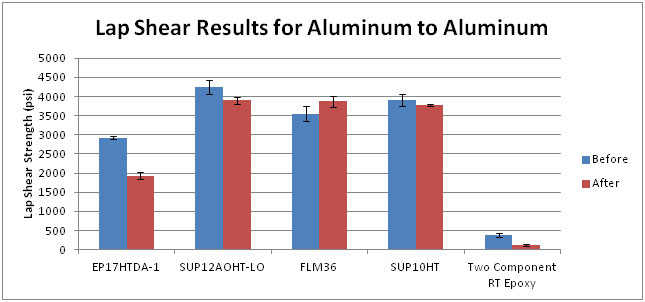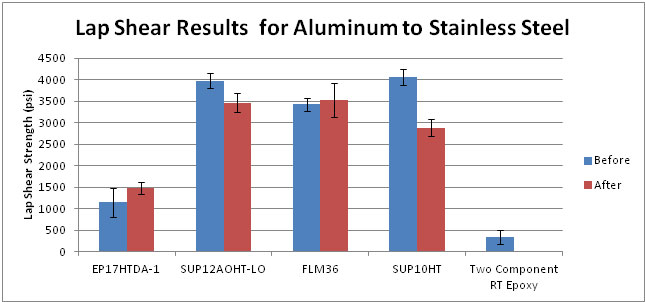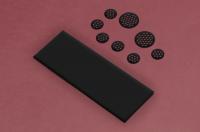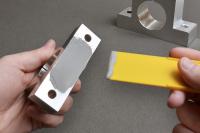Select Master Bond adhesives have been engineered to retain mechanical strength properties after prolonged exposure to elevated temperatures. This strength retention was recently demonstrated in a study performed by Master Bond involving several structural adhesives. These results were then compared with a standard two component, room temperature curing epoxy.
Importance of Lap Shear Strength
Lap shear stress is one of the most common stresses that a bonded joint faces during service, especially in structural bonding applications. The lap shear strength of an adhesive serves not only as a good gauge for an adhesive’s structural strength profile, but it is also an indicator for a bonded joint’s long term sustenance in an application context.
The industry standard for measuring lap shear strength for adhesives is the ASTM D-1002, wherein aluminum coupons are bonded together in a lap joint with an adhesive applied between the substrates and cured. The parts are then sheared at incremental loads in the tensile mode, and therefore referred to as tensile lap shear.
Test Conditions
Resistance to elevated temperatures is a critical factor for many aerospace, electronics, and oil & gas applications, where high temperature resistance is generally considered as a good indicator of performance under harsh environments. In order to test the long term sustenance of adhesives in an application context, Master Bond simulated an environment in which bonded lap joints were subjected to high temperatures for long periods of time. The experiment involved performing a before and after (exposure to high temperatures) lap shear strength measurement. The lap shear was tested for aluminum to aluminum. Metal coupons roughly measuring 4” x 1” x 1/16” were roughened and cleaned with acetone, prior to adhesive application.
These metal substrates were bonded together and the adhesive cured according to the recommended cure schedule. They were then subjected to 500 hours of exposure to 300°F (~ 150°C). Adhesives EP17HTDA-1, Supreme 12AOHT-LO, FLM36, and Supreme 10HT were selected considering their relatively high Tg and good lap shear strength at room temperature. EP17HTDA-1, Supreme 12AOHT-LO, and Supreme 10HT were cured at 250°F (125°C) for 2 hours followed by 300°F (150°C) for 5 hours. The cure schedule for FLM36 was 300°F (150°C) for 4 hours followed by 350°F (175°C) for another 4 hours.
Results for Aluminum to Aluminum Bond Strength Test
Five bonded samples of each system were tested and compared to a standard two component epoxy that cures at room temperature. The results in the graph below display the lap shear strength of these adhesive systems before and after heat exposure. They also are average values along with error bars indicating a narrow standard of deviation between readings.

The outcomes show that the four systems were not significantly affected despite exposure to aggressive temperature conditions. Although EP17HTDA-1 had the biggest loss in lap shear strength, the lap shear strength value after this high temperature condition was still pretty high. FLM36 and Supreme 12AOHT-LO displayed the highest lap shear strength for bonding similar substrates after prolonged exposure to high temperatures, with the Supreme 10HT not too far behind. All four adhesives displayed much higher lap shear strength than a typical two component room temperature curing epoxy.
Results for Aluminum to Stainless Steel Bond Strength Test
In a second experiment, lap shear strength is tested for aluminum to stainless steel bonding, before and after prolonged heat exposure. The substrates were prepared and cured as noted above for the aluminum to aluminum bonding.

Again, results show that the four systems were not significantly affected despite exposure to aggressive temperature conditions. Here, FLM36 and Supreme 12AOHT-LO displayed the highest lap shear strength retention for bonding dissimilar substrates.
To summarize, these products have demonstrated their ability to maintain excellent mechanical strength properties, even after prolonged exposure to elevated temperatures. It is also important to note that heat curing or post heat curing epoxy adhesives will significantly improve their temperature resistance and strength properties.
For more information on high temperature or high strength epoxies from Master Bond, please contact our technical advisors.
Disclaimer: The findings in this article are not meant to be used for specification purposes.
High Lap Shear Strength Adhesives of Structural Adhesives
 |
EP17HTDA-1 Single component heat curable epoxy adhesive/sealant. Non-drip system. Resists up to 525°F. Meets NASA low outgassing specifications. Meets MIL-STD-883J Section 3.5.2 for thermal stability. High lap shear, tensile and compressive strength. Tg of 230-240°C after post cure. |
 |
Supreme 12AOHT-LO One component, heat cure system for bonding, sealing. High strength product. Service operating temperature range from 4K to +500°F (260°C). Resists aggressive thermal cycling and shock. Substantial thermal conductivity of 9-10 BTU in/ft2 hr °F. Smooth thixotropic paste. NASA low outgassing approved. Meets MIL-STD-883J Section 3.5.2 for thermal stability. Withstands 1,000 hours 85°C/85% RH. |
 |
FLM36 B-staged film adhesive/sealant. Outstanding thermal cycling capabilities and structural properties. Offers superior toughness and flexibility. Excellent strength retention at elevated temperatures. Thermally conductive/electrically insulative. Provides uniform bond line thickness. Serviceable from -100°F to +500°F. Preforms are available. |
 |
Supreme 10HT One part structural epoxy with high bond strength and excellent adhesion to similar and dissimilar substrates, especially composite materials. Requires oven curing at 250-300°F. NASA low outgassing approved. Serviceable from 4k to +400°F. Tough and durable. 85°C/85% RH resistance. |
